Key Developments in the History of
Buttress Dams
|
Roman Buttress Dams
Esparragelejo
Whenever Roman engineers, often erroneously, judged the stability of a dam wall to be
inefficient, they backed it up by irregularly spaced buttresses. But some dams were too thin. Buttress could not prevent the failure of
the super thin, 0.9 m dam wall at Ituranduz. By contrast, some dams were over designed.
The Olisipo dam was 6.5 m thick and didn't need help from its buttresses. The most
remarkable of the Roman buttress dams is the one near the village of Esparragalejo.
The 5.6 m high and 320 m long dam was supported in its central part with 12 buttresses
averaging 1.2 m wide, 3.2 m thick and spaced 8.6 m apart. However, the novel feature
was that the downstream face of the 2 m wide dam wall became curved between the
buttresses. Thus, the first multiple arch dam was born!
|
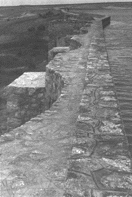
The Esparragelejo Dam
photo from Schnitter
courtesy of
A.A. Balkema (#)
|
Buttress Dams in Postmedieval Europe
Castellar
The Castellar storage dam in Spain was built around 1500 and had three water
wheels to power its mill house. The sturdy end and walls of the mill house
were actually buttresses ensuring the dam's stability. It is certainly no
coincidence that this structural concept re-emerged in a region in which the
Romans had built many buttress dams. |
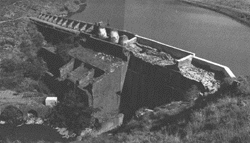
The Casterllar Dam
photo from Schnitter
courtesy of
A.A. Balkema (#)
|
Evolution of the Modern Buttress Dam
Today we understand buttress dams as derivations from the massive gravity type
with the introduction of intermediate spaces. These spaces allows the discharge of
water seeping through the dam and its foundation, thus greatly reducing uplift
pressures. Given the absence of uplift, more substantial savings were possible by
inclining the upstream face, thereby mobilizing the vertical water load on the
upstream face for sliding stability.
|
|
Multiple Arch
The first multiple arch dam of reinforced concrete had been completed in 1908.
It impounded the Hume Lake fluming reservoir on the Ten Mile creek in the
California Sierra Nevada Mountains. The dam was designed and supervised
during constuction by John S. Eastwood (1857-1924). He also designed the Big
Bear Valley dam in the San Bernardino mountains. Eastwood's designs were
very economic: the required less concrete than an equivilant gravity dam and
cost less, too. Overall, a dozen multi-arch dams were built in the following
decade and a half according to Eastwood's design.
Check out a book on Eastwood. |
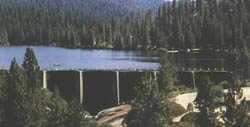
The Hume Dam
photo courtesy of Bill Huf
USDA Forest Service (#)
|
|
A decidely larger arch span of 54.9 m was acheived in 1928 at the 76 m high
Coolidge Dam in Arizona. This was the first application of the double-curved dome structure
to buttress dams. Coolidge Dam provides water for irrigation, power, and recreation. |
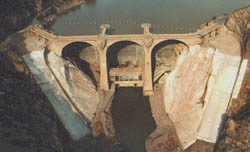
The Coolidge Dam
photo from US Bureau of Reclamation
|
|
After World War II, large-span multiple-arch dams were pursued further by the
prominent French dam designer Andre Coyne (1891-1960).
After the war, several of them were built in France, among such sizable structures
as the 88m high Grandval Dam built in 1959 with a 50 m span. However, Coyne's most
important project of this type was built in the years from 1961 to 1968 in northern
Canada. On the Manicougan river in Quebec was built the Daniel Johnson dam. It was
an unprecedented 214 m high with a central span of 162 m and smaller side spans of
76 m each!! Unfortunately, the elegant structure was plagued by numerous
cracks. |
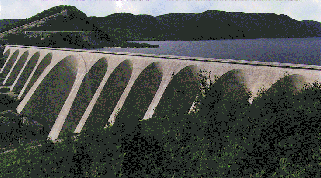
soon: The Daniel-Johnson Dam
photo from Hydro-Quebec (#)
|
|
Flat Slab Buttress
The hottest competitor to multiple arch was the type of flat slab buttress designed
and patened by Nils F. Abursen in 1903. Abursen's design took full advantage of the
stabillizing effect of the vertical water load on the strongly inclined upstream
face, which required a minimal buttress thickness per unit of dam length. The
Abursen dam type soon became quite popular and, by the end of the 1920's, more than
200 had been constructed, thus outnumbering multiple arch dams by far. |
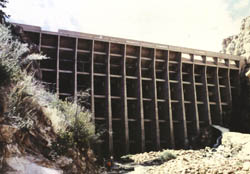
The Le Prele Dam
photo from Kollgaard and Chadwick
|
|
Contiguous Butresses
There was an introduction of a new kind of design in which the arches or slabs as
upstream closures of the intermediate spaces between the buttresses were replaced by
a thickening of their heads to make them contiguous. The Dixence dam in Switzerland had II
shaped buttresses. It was the world record in height for a buttress (87m) dam until
after WWII. This dam has now been submerged by the reservoir from the Grand Dixence
gravity dam in 1957. |
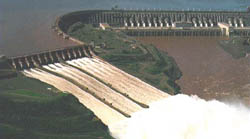
The Itaipu Dam
photo from Itaipu Binacioinal
|
|
|
 
|


